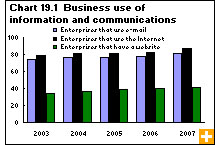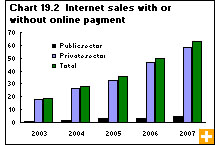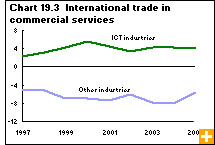Common menu bar links
Information and communications technology
Archived Content
Information identified as archived is provided for reference, research or recordkeeping purposes. It is not subject to the Government of Canada Web Standards and has not been altered or updated since it was archived. Please contact us to request a format other than those available.
Look back 30 years and you will see a world where the telephone, television and radio were the most visible information and communications technologies (ICTs).
The telecommunications services industry has changed significantly as a result of increased competition in all markets. New players have joined the industry. For instance, cable companies are delivering telecommunications services such as Internet access and local telephone service in addition to television services.
Now personal computers, cellphones and the Internet are the ICTs central to how we live our lives and conduct our business. New ICTs are being developed and marketed, older ones are being improved and transformed, and we are devoting more money and time working, playing and communicating with them.
In 2006, cable companies accounted for 54% of high-speed residential Internet subscribers. Cable companies started offering local telephone service in 2005 and, by the end of 2006, served 12% of local residential lines.
In 2006, over 99% of Canadian households had landline or mobile telephone service. Sixty-eight percent of households had home Internet access, the large majority with high-speed service; 1 in 10 households used dial-up. Canada has the highest broadband subscription rate among the G8 countries.
More than three-quarters of Canadian households reported owning a computer in 2006, while 31% of households reported buying new computer hardware.
As for businesses, 87% of private-sector organizations used the Internet in 2007, while 81% used e-mail and 41% had a website. All these rates have increased by close to 8 percentage points since 2003. Internet usage in 2007 varied significantly: from 100% for the educational services sector to 73% for the forestry sector.
Selling online
With the widespread use of the Internet, electronic commerce continues to gain strength; 2007 marked the sixth consecutive year of double-digit growth for online sales.
Total private- and public-sector Internet sales totalled $62.7 billion, up 26% from 2006. Customers outside Canada generated an estimated 19% of the value of online private-sector sales in 2007.
However, Internet sales still account for slightly less than 2% of total operating revenue of private sector firms. The private sector reported $58.2 billion in e‑commerce; the public sector nearly $4.5 billion. In the private sector, while the majority of online sales are business-to-business, that dominance is decreasing: in 2007, business-to-business accounted for 62% of online sales, down from 68% in 2006, while business-to-consumer sales climbed from 32% to 38%.
However, the proportion of online business-to-business versus business-to-consumer sales varied by sector. For example, in the retail trade, accommodation and food services, educational services, and arts, entertainment and recreational sectors most sales were to consumers.
Four sectors accounted for the majority of the value of online sales: wholesale trade (17%), transportation and warehousing (16%), manufacturing (15%) and retail trade (10%). Still, not all companies in those sectors are selling online. In 2007, 27% of firms in the information and cultural industries sectors, and 24% of those in the arts, entertainment and recreational industries sold goods or services online.
Spending personal time online
Almost three-quarters of Canadians aged 16 or older went online for personal reasons over the 12-month period ending in October/November 2007. Those 19.2 million people used the Internet from home for a diverse range of activities. The most popular were e-mail and general browsing.
Other common activities were finding government or health information, making travel arrangements, banking, paying bills, and ordering goods and services.
As well, 20% of home Internet users reported contributing content by posting images, writing blogs or participating in discussion groups. Of that 20%, more than half were under the age of 30.
Different age groups showed distinct differences in Internet use. For example, in 2007, 96% of people aged 16 to 24 went online, compared with 29% of those aged 65 and older.
Nearly three-quarters of both men and women used the Internet in 2007, but men were online more often and for longer periods than women.
Ongoing change in telecommunications services
The importance of telecommunications services in our lives is reflected in the revenues earned by service providers. In 2006, those revenues reached $36.1 billion, up $1.6 billion or 4.5% over 2005. This was largely attributable to the increased revenue growth from mobile phone and Internet services. Mobile phone service revenues showed 15% year-over-year growth, while Internet service revenues jumped 18%.
Change in our use of services continues to escalate, with technological improvements and increased availability of phone service alternatives. In December 2007, 24% of Canadian households reported using only a traditional landline service, down from 29% a year earlier. Conversely in December 2007, 72% of households reported having at least one cellphone, up from 67% a year earlier. Over the year, the number of cellphone-only households grew from 5% to 6%.
International markets for ICT services
Canada’s ICT services sector does not share the usual trade balance pattern for services. Services—which comprise the four major categories of travel, transportation, commercial and government services—had a trade deficit of $12.2 billion in 2005. However, trade in ICT commercial services posted a trade surplus of $4.0 billion.
Commercial services cover a broad range of activities such as insurance, management, architecture, royalties, fees and licences, informatics and information, engineering and technical services, and research and development. ICT commercial services transactions were in such areas as computer services, software publishing and telecommunications. Within the ICT sector, the information and cultural industries accounted for 54% of the 2005 ICT commercial services trade surplus.





